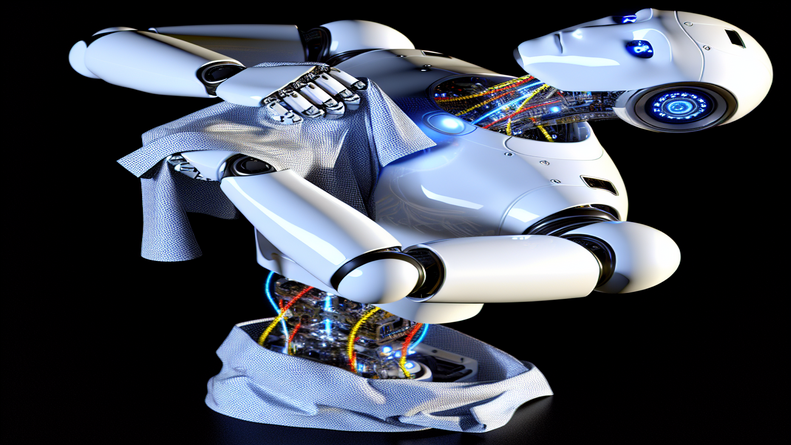Imagine living in a world where robotics is much more than a mere tool; it is a consistent source of amazement and efficiency. The world is already witnessing such a change, with Tesla’s humanoid robots controlling the realms of technology and innovation, and offering ingenious solutions to everyday tasks. So, the question here is, can these humanoid robots serve as a persistent source of awe and utility? Can Elon Musk’s ambitious Optimus project evolve into a catalyst for major shifts in industry standards? This blog post sheds light on these questions and offers an inspiring glimpse into the future as we watch Optimus accomplish a seemingly mundane yet remarkably intriguing task: folding a t-shirt.
The Dawn of In-House Robotics
The journey of in-house robotics, specifically Tesla’s Optimus humanoid project, begins with the aspiration to merge practicality with advanced artificial intelligence. The vision of robots performing domestic chores is not novel, but witnessing one take on the subtlety and finesse required for folding a t-shirt provides a stark indicator of the technological marvels on the horizon. The tactile movements, the careful grasp of the fabric, and the methodical approach to a task that’s considered insipid for humans, marks the inception of this dream’s realization.
Despite its seeming simplicity, the action of folding a t-shirt represents a complex interplay of sensors, motors, and programming, converging into a harmonious dance of robotics. Optimus, more than a machine, becomes the embodiment of Tesla’s focus on robotics that go beyond industrial applications to become part of the fabric of daily life.
Navigating a Watershed Moment
Elon Musk’s revelation of Optimus folding a t-shirt is not just about sharing progress footage; it’s a watershed moment indicating a shift in robotics perception. Beyond performing predefined industrial motions, Optimus’s success in a garment-folding task showcases adaptability and learning—key traits for robotic integration into human environments. Such a moment is analogous to the early stages of humanity discovering fire; a fundamental tool, yet one sparking an era of transformation.
This seemingly innocuous demonstration transcends mere functionality. It becomes a discourse on the future relationship between humans and robots—one marked by seamless collaboration, where robots not only serve but also anticipate and adapt to human needs, redefining the landscape of consumer robotics.
Planting Seeds for Growth
 The Optimus project’s incremental progression represents Tesla’s calculated approach to robotic development. From simple tasks progression to potentially tackling complex domestic chores, each stride made by Optimus plants a seed for exponential growth in robotics capabilities. It’s the painstaking attention to the smallest details that lays the groundwork for a future where robots are not just assistants but integral members of our households.
The Optimus project’s incremental progression represents Tesla’s calculated approach to robotic development. From simple tasks progression to potentially tackling complex domestic chores, each stride made by Optimus plants a seed for exponential growth in robotics capabilities. It’s the painstaking attention to the smallest details that lays the groundwork for a future where robots are not just assistants but integral members of our households.
Scaling up in this context does not merely refer to production numbers; it’s about scaling functionalities, usability, and human-robot interactions to a global domestic audience. Herein, Musk’s Optimus enters as both protagonist and pioneer, transforming not just how tasks are done, but also who—or what—does them.
Absorbing the Lessons from Innovation
The evolution of Optimus offers a wealth of knowledge. It becomes evident that the path to harmony between robotics and daily life is forged with patience, constant feedback, and a relentless pursuit of innovation. Team synergy at Tesla ensures an environment where setbacks are learning avenues, leading to ground-breaking developments.
However, one must tread cautiously. As robots like Optimus entwine more intricately with human lives, privacy, ethical use, and emotional intelligence become crucial considerations for developers. This lesson from Musk’s quest for robotic advancement calls for collective foresight, ensuring technology serves humanity beneficially.
A Crystal Gaze into Tomorrow
The spectacle of Optimus’s seemingly simple t-shirt fold unfolds into a panoramic view of possibilities for future ventures. Expansion plans for Optimus could branch into various sectors: healthcare, where robotic precision can assist surgeries; eldercare, where companionship meets utility; or even education, with interactive and personalized teaching methods.
Envisioning a tomorrow replete with humanoid assistance, Tesla’s trajectory hints at not just fruitful commercial prospects, but also at a new era of human-robot symbiosis, where robots enhance life quality beyond commercial motives, and where the canvas of potential applications spans boundless horizons.
Conclusion
The narrative of Elon Musk’s Tesla Optimus humanoid robot epitomizes the entrepreneurial spirit’s transformative power. It’s about the culmination of imagination, technological finesse, and ceaseless labor towards an aspiration set to reshape societal norms. Optimus is more than gears and codes; it’s resilience, innovation, and a beacon for visionary futurism leading to a more efficient, enriched human experience.Connect with me on [Laurent Rochetta’s LinkedIn page](https://www.linkedin.com/in/laurentrochetta/) to explore how breakthroughs like Tesla’s Optimus can spark transformative ideas for our collective future. 🚀🤖
